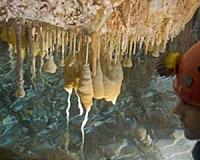| . |  |
. |
Quebec City, Canada (SPX) Feb 18, 2010 The southern limit of permanently frozen ground, or permafrost, is now 130 kilometers further north than it was 50 years ago in the James Bay region, according to two researchers from the Department of Biology at Universite Laval. In a recent issue of the scientific journal Permafrost and Periglacial Processes, Serge Payette and Simon Thibault suggest that, if the trend continues, permafrost in the region will completely disappear in the near future. The researchers measured the retreat of the permafrost border by observing hummocks known as "palsas," which form naturally over ice contained in the soil of northern peat bogs. Conditions in these mounds are conducive to the development of distinct vegetation-lichen, shrubs, and black spruce-that make them easy to spot in the field. In an initial survey in 2004, the researchers examined seven bogs located between the 51st and 53rd parallels. They noted at that time that only two of the bogs contained palsas, whereas aerial photos taken in 1957 showed palsas present in all of the bogs. A second assessment in 2005 revealed that the number of palsas present in these two bogs had decreased over the course of one year by 86% and 90% respectively. Helicopter flyovers between the 51st and 55th parallels also revealed that the palsas are in an advanced state of deterioration over the entire James Bay area. While climate change is the most probable explanation for this phenomenon, the lack of long term climatic data for the area makes it impossible for the researchers to officially confirm this. Professor Payette notes, however, that the average annual temperature of the northern sites he has studied for over 20 years has increased by 2 degrees Celsius. "If this trend keeps up, what is left of the palsas in the James Bay bogs will disappear altogether in the near future, and it is likely that the permafrost will suffer the same fate," concludes the researcher affiliated to the Centre d'etudes nordiques.
Share This Article With Planet Earth
Related Links Universite Laval Beyond the Ice Age
 Research Challenges Models Of Sea Level Change During Ice-Age Cycles
Research Challenges Models Of Sea Level Change During Ice-Age CyclesIowa City IA (SPX) Feb 17, 2010 Theories about the rates of ice accumulation and melting during the Quaternary Period - the time interval ranging from 2.6 million years ago to the present - may need to be revised, thanks to research findings published by a University of Iowa researcher and his colleagues in the journal Science. Jeffrey Dorale, assistant professor of geoscience in the UI College of Liberal Arts and Scienc ... read more |
|
| The content herein, unless otherwise known to be public domain, are Copyright 1995-2010 - SpaceDaily. AFP and UPI Wire Stories are copyright Agence France-Presse and United Press International. ESA Portal Reports are copyright European Space Agency. All NASA sourced material is public domain. Additional copyrights may apply in whole or part to other bona fide parties. Advertising does not imply endorsement,agreement or approval of any opinions, statements or information provided by SpaceDaily on any Web page published or hosted by SpaceDaily. Privacy Statement |